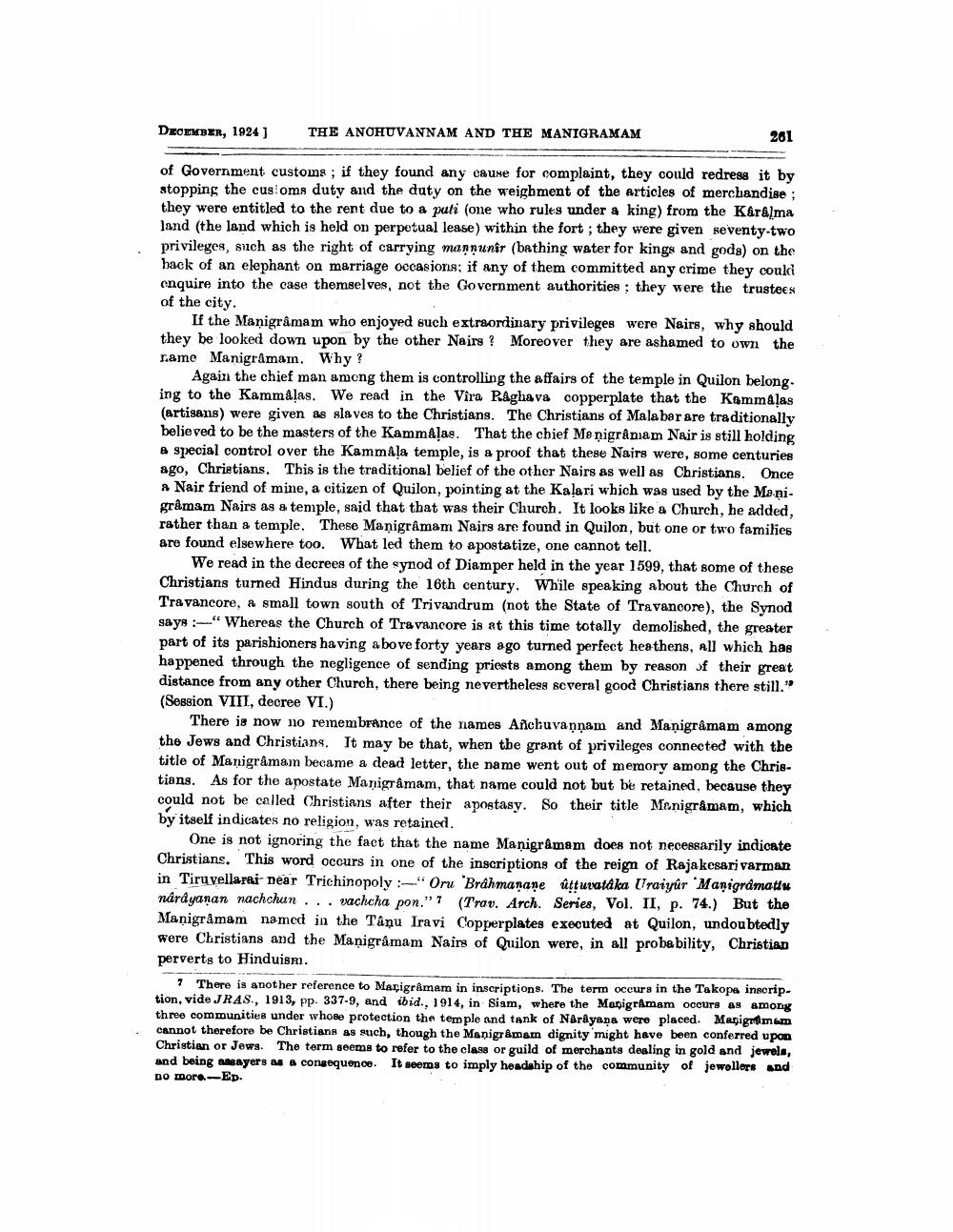________________
DECEMBER, 1924] THE ANOHUVANNAM AND THE MANIGRAMAM
of Government customs; if they found any cause for complaint, they could redress it by stopping the customs duty and the duty on the weighment of the articles of merchandise; they were entitled to the rent due to a pati (one who rules under a king) from the Kârâlma land (the land which is held on perpetual lease) within the fort; they were given seventy-two privileges, such as the right of carrying manṇunir (bathing water for kings and gods) on the hack of an elephant on marriage occasions: if any of them committed any crime they could enquire into the case themselves, not the Government authorities; they were the trustees of the city.
261
If the Manigramam who enjoyed such extraordinary privileges were Nairs, why should they be looked down upon by the other Nairs? Moreover they are ashamed to own the rame Manigramam. Why?
Again the chief man among them is controlling the affairs of the temple in Quilon belong. ing to the Kammalas. We read in the Vira Raghava copperplate that the Kammalas (artisans) were given as slaves to the Christians. The Christians of Malabar are traditionally believed to be the masters of the Kammalas. That the chief Me nigrâmam Nair is still holding a special control over the Kammåla temple, is a proof that these Nairs were, some centuries ago, Christians. This is the traditional belief of the other Nairs as well as Christians. Once a Nair friend of mine, a citizen of Quilon, pointing at the Kalari which was used by the Manigrâmam Nairs as a temple, said that that was their Church. It looks like a Church, he added, rather than a temple. These Manigramam Nairs are found in Quilon, but one or two families are found elsewhere too. What led them to apostatize, one cannot tell.
We read in the decrees of the synod of Diamper held in the year 1599, that some of these Christians turned Hindus during the 16th century. While speaking about the Church of Travancore, a small town south of Trivandrum (not the State of Travancore), the Synod says: Whereas the Church of Travancore is at this time totally demolished, the greater part of its parishioners having above forty years ago turned perfect heathens, all which has happened through the negligence of sending priests among them by reason of their great distance from any other Church, there being nevertheless several good Christians there still." (Session VIII, decree VI.)
There is now no remembrance of the names Añchuvannam and Manigramam among the Jews and Christians. It may be that, when the grant of privileges connected with the title of Manigramam became a dead letter, the name went out of memory among the Christians. As for the apostate Manigramam, that name could not but be retained, because they could not be called Christians after their apostasy. So their title Manigramam, which by itself indicates no religion, was retained.
One is not ignoring the fact that the name Manigramam does not necessarily indicate Christians. This word occurs in one of the inscriptions of the reign of Rajakesari varman in Tiruvellarai near Trichinopoly: Oru "Brahmanane ûṭṭuvataka Uraiyûr 'Manigramattu narayanan nachchan... vachcha pon." (Trav. Arch. Series, Vol. II, p. 74.) But the Manigramam named in the Tânu Iravi Copperplates executed at Quilon, undoubtedly were Christians and the Manigramam Nairs of Quilon were, in all probability, Christian perverts to Hinduism.
7 There is another reference to Marigrâmam in inscriptions. The term occurs in the Takopa inscription, vide JRAS., 1913, pp. 337-9, and ibid., 1914, in Siam, where the Manigramam occurs as among three communities under whose protection the temple and tank of Narayana were placed. Manigramam cannot therefore be Christians as such, though the Manigramam dignity might have been conferred upon Christian or Jews. The term seems to refer to the class or guild of merchants dealing in gold and jewels, and being assayers as a consequence. It seems to imply headship of the community of jewellers and no more-ED.




